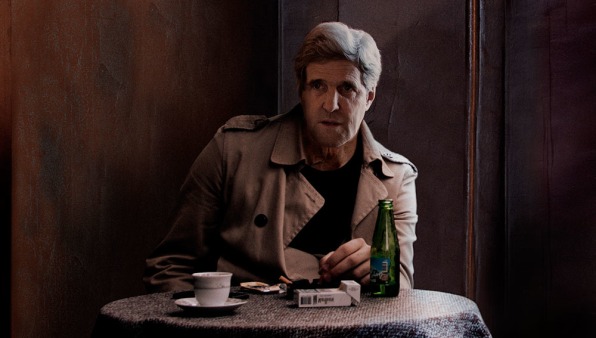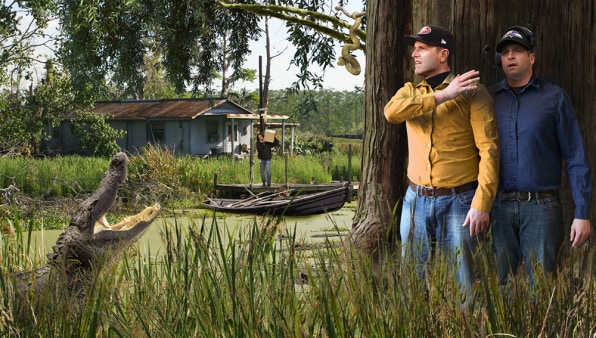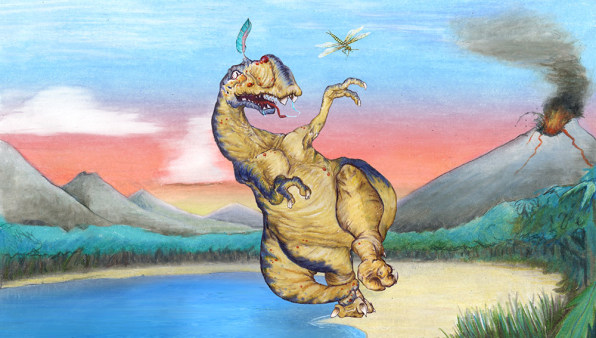Funny Sneaking Away From a Crime Art
An Onion article titled "New Law Enforcement Robot Can Wield Excessive Force Of 5 Human Officers" includes a remarkable bit of artwork, which you can see above: a muscled, armored tank-like robot armed with guns and probes and sprays and hammers, using all its weaponry to attack the business-casual-clad attendees of a beige-carpet trade show. To create it, The Onion's art department built a digital robot, staged the scene with real people, then combined original photography and digital art with pre-existing stock photography to achieve a perfectly surreal, violent scene. All to illustrate a joke that can be told in a 12-word headline.
This is hardly an isolated example. At The Onion, a fake news website and one of the great satirical outposts of the past 50 years, nearly every image is original: either a graphic created in-house, a photograph taken in-house, or an image so manipulated by Photoshop as to not represent any real event that has ever happened. The tiny graphics team at The Onion pumps out about 50 original pieces of art per week at a time when your average Internet publication arts stories as quickly as possible: with images the subject provided, or photographs from stock agencies and wire services. Nobody sits down and creates original art for a two-sentence post. Yet The Onion does, over and over again. Why bother?

As Stephen Colbert or any great satirist will tell you, a key to satire is to always stay in character. In The Onion's case, that "character" is an absurd, alternative world invented to comment on the real one. Every aspect of the fake world has to ring true for the trick to work. That includes the visuals. When nothing you publish is real, every single image has to be made from scratch. "We want to make sure that we're making our Onion-world fully realized and very real," says Ben Berkley, managing editor of The Onion. It's all in service of the joke.
A Real (Fake) History
There is a real history of The Onion–started by two college students at the University of Wisconsin at Madison in 1988, eventually moved to New York and then, recently, back west to Chicago–but there's also a fake history created by the writers of The Onion itself. In this history, The Onion was founded by a German immigrant named Friedrich Siegfried Zweibel ("zwiebel" is German for "onion") in 1765, named the "Mercantile Onion" because, according to The Onion book "Our Dumb Century," those were the only two English words Zweibel knew. Also in the fictional history of The Onion: The Onion News Network, ONN, was founded several years before television itself was invented; the grandson of the founder, editor T. Herman Zweibel, a conservative firebrand who once opposed television characters sleeping in the same bed, eventually left the planet Earth; and in the span of a week in 2009, The Onion was sold to a Chinese conglomerate Yu Wan Mei Amalgamated Salvage Fisheries and Polymer Injection Corporation and subsequently sold by the same Chinese conglomerate.
That skewed, surreal tone permeates The Onion's strange editorial approach–a combination of fake New York Times and fake cheeseball local paper–along with a few other publications taking on other media types. Notably, that includes the new site Clickhole, a parody of pageview-desperate posts on sites ranging from BuzzFeed to the Huffington Post to Upworthy. (Clickhole has its own photo editor, and the teams for The Onion's videos are separate. Even more separate is the AV Club, a non-satirical criticism and reviews site, formerly a section within the physical Onion newspaper, that discusses movies, TV, books, games, and music.)

Today, The Onion has, according to its press site, about 11 million unique visitors a month, and Alexa, the moderately reliable site ranking system, puts it in the top 600 sites in America.
The Power Of A Three-Person Art Department
Eric Ervine, Jimmy Hasse, and Heidi Unkefer make up the entire art department of The Onion, producing about 50 original images per week for theonion.com (Nicole Antonuccio handles the art for Clickhole). "Calling them artistic wizards is a disservice to their talents," managing editor Berkley says. "Really, it's a travesty that Adobe hasn't renamed Photoshop after them."
Everything at The Onion starts with the headline. As documented in this great This American Life episode, the pitch table at The Onion is difficult, with the surprisingly small staff pitching thousands of headlines per week to be boiled down to a couple dozen. It is a brutal job, and writers at The Onion don't even get bylines, so nobody can tell who wrote what–an extreme, but thematically sound continuance of the alternate-reality newspaper concept. After the headline is approved, it's taken to the art department. "Every image has to be in lockstep with the story it's illustrating," Berkley says. "For example, if we have a story about Obama and his facial expression doesn't align with the tone of the piece, then it changes or confuses the whole joke." And there are plenty of stories where the image is the entirety of the story: All you see are a headline and an image.
Images relying on public figures have to be heavily altered. Often an image to illustrate a celebrity or politician is actually a Photoshopped amalgamation of several different stock or wire images, layer upon layer added to separate the real world in which the event being riffed on actually happened from the Onionworld. That's simple enough, assuming you're a brilliant and quick-minded Photoshop wizard; there are similar staffs at The Daily Show with Jon Stewart, for example.
Where The Onion gets truly weird is in its faux-local coverage–the archetypical "Area Man." Area Man is one of The Onion's longest-running memes, a take on the silliness and pomposity given to local schlubs by local news teams. But since none of these stories actually happened, The Onion's art department has to create, from scratch, thousands of different "everyday" scenarios. Some recent ones: "Area Man Pretty Sure He Knows Which Athletes Are Gay," "Area Man Too Poor To Afford Movers, Too Old To Get Help From His Friends," "Area Man Lacks Star Power Necessary To Carry Major Motion Picture." These images call for subtle, banal shots, which can become totally forgettable or sell the joke by giving it the weight of a constructed world.

The method for creating the banal Onionworld relies on interns, employees, their significant others and friends, and their apartments. "Everybody in this office has had the experience where one of the graphics editors will be walking around with a camera and you see them walk toward your desk and they tap you on the shoulder," Berkley says. "Personally I've been two superheroes, two teens, and a body double for Vice President Biden." Scott Rogowsky, a former writer for Onion properties, appeared as a temporary priest in the story "Priest Shortage Forces Vatican To Hire Temps To Deliver Sacred Rites." Rogowsky says the photo director at the time, Nick Gallo, had a huge Rolodex of names he could consult for shoots like this. "I guess he wanted someone who had a beard and looked like a semi-employed bum, which I was," Rogowsky says.
Some of the pieces are harder than others. Take two intensive pieces, both favorites of the writing staff. "More Corporations Using Tag And Release Programs To Study American Consumers" is primarily an original photograph of two "marketers" shooting a man with a tranquilizer dart. The photo was minimally altered; the only part added afterward the shot, says senior graphics editor Eric Ervine, is the little yellow dart. It's a classic Onion image: the low-key, casual setting (it takes place in the parking lot of Jewel, a chain of Chicago supermarkets), the businesslike attire of all the people in the scene, and then a violent or surreal twist. The image that accompanies the article "Fossilized Evidence Reveals Spazosaurus Was Largest Doofus To Ever Roam Earth" took a different kind of effort. It's a truly ridiculous, watercolor-like illustration of an idiot clumsy chunky dinosaur, bearing no relation to any dinosaur I've ever seen, tripping over its own tail while drooling. "I just love this one," says senior editor Eric Ervine. "It's so rare we get to do a full-blown illustration, especially with this level of irreverent zaniness."

What The Onion does is more difficult than it seems; just look at less successful copycats, like the Daily Currant, to see what a high-wire act satirical journalism is. But The Onion is doing more than just writing fake news; with just a handful of writers and a three-person art department, it has managed to create what television and movies often fail to do: a fully-functioning, fascinating world just different enough from our own to serve as a damning critique of it.
Source: https://www.fastcompany.com/3033865/the-look-of-funny-how-the-onions-art-department-work
0 Response to "Funny Sneaking Away From a Crime Art"
Post a Comment